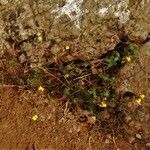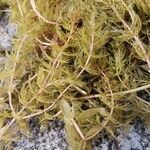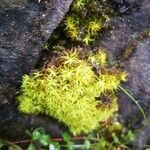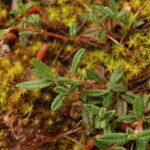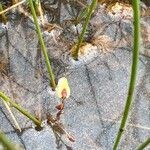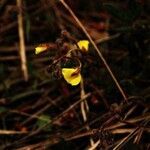Perennials, usually affixed aquatic. Rhizoids absent. Stolons filiform, terete, sparsely branched, some green, others without chlorophyll. Traps lateral on leaf segments, shortly stalked, ovoid, 0.8-2.5 mm, mouth lateral; appendages 2, dorsal, long, branched, setiform, with a few lateral simple setae. Leaves numerous on green stolons, semicircular to suborbicular in outline, 2-15 × 3-15 mm, palmately divided from base into 2 or 3 primary segments; primary segment dichotomously divided from base into 2-11 further segments; ultimate segments flattened, narrowly linear, 0.1-0.5 mm wide, margin entire or sparsely denticulate, apex acute, apex and teeth with or without microscopic setulae. Inflorescences erect, 5-20(-25) cm, 2-8-flowered, glabrous; peduncle terete, 0.3-1 mm thick; scales 2-4, similar to bracts; bracts basifixed, broadly ovate to ovate-deltoid, 1.5-2 mm, base conspicuously auriculate, apex acute to obtuse. Pedicel erect at anthesis but spreading and decurved in fruit, terete, 4-8 mm; bracteoles absent. Calyx lobes broadly ovate, 2-3 mm, subequal; lower lobe smaller, apex narrowly truncate; upper lobe apex subacute. Corolla lemon-yellow, 6-8 mm; lower lip broadly obovate, margin deflexed, apex rounded to retuse; spur saccate to obtusely broadly conic; palate elongate, with a raised marginal rim, distally narrowed and glandular; upper lip ovate to ovate-oblong, apex retuse. Filaments ca. 1.5 mm, curved; anther thecae ± distinct. Ovary broadly ellipsoid; style relatively long; stigma lower lip broadly ovate and ciliate, upper lip deltoid and apex acute or 2-or 3-cleft. Capsule globose, 2-3 mm in diam., circumscissile. Seeds lenticular-prismatic, 0.3-0.4 × ca. 1 mm, scarcely winged on angles; seed coat with small prominent ± isodiametric reticulations. Fl. Aug-Sep, fr. Sep-Oct. 2n = 40, 44.
Stems mostly creeping on the soil and forming mats under shallow water; lvs numerous, mostly 0.3–1 cm, commonly 3-parted at base and then dichotomous or irregularly 1–3 times divided, the segment slender, flat, the ultimate ones strongly acuminate; fls mostly 2–9(–15) in a lax raceme on an emergent peduncle 4–15 cm; pedicels soon arcuate-recurved; cor yellow, the lower lip 4–8 mm, twice as long as the upper, the palate scarcely developed; the spur small, to half as long as the lower lip; 2n=44. Shallow water; circumboreal, s. to N.J., Ind., and Calif.
